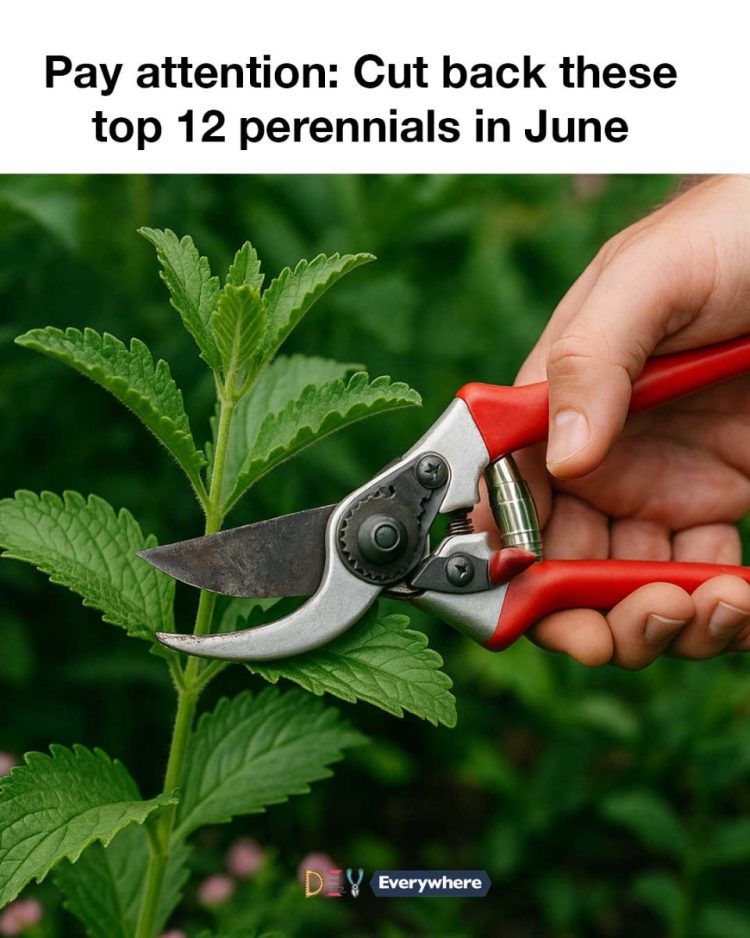This practice not only promotes a second round of blooms but also helps maintain the plant’s shape and size. By preventing the plant from becoming too woody or overgrown, gardeners can ensure that Salvia remains a focal point in the garden throughout the summer months.
6. Catmint: Maintain a Tidy Appearance
Catmint, known for its aromatic foliage and lavender-blue flowers, can quickly become unruly if not pruned regularly. In June, after the first flush of blooms, it’s beneficial to cut back Catmint by about half. This encourages a more compact growth habit and a second wave of flowering.
Pruning Catmint also helps prevent the plant from flopping over, which can occur when stems become too long and heavy. By maintaining a tidy appearance, gardeners can enjoy the beauty and fragrance of Catmint without it overwhelming the garden space.
7. Geranium: Stimulate Fresh Growth
Hardy geraniums, with their delicate flowers and lush foliage, benefit from a mid-season trim. After the initial bloom period, cutting back the plant by about one-third can stimulate fresh growth and potentially a second round of blooms.
This practice also helps manage the plant’s size and encourages a more compact growth habit. By removing spent flowers and leggy stems, gardeners can keep geraniums looking their best throughout the summer.
8. Delphinium: Prepare for a Second Show
Delphiniums are known for their tall, striking flower spikes. After the first bloom, cutting back the flower stalks to the base can encourage a second, albeit smaller, flowering later in the season. This not only extends the blooming period but also helps maintain the plant’s health.
Pruning Delphiniums in June also prevents the plant from expending energy on seed production, redirecting it towards new growth and blooms. Additionally, cutting back spent flower spikes helps keep the garden neat and reduces the risk of disease.
9. Phlox: Prevent Mildew and Encourage Blooms
Phlox is prone to powdery mildew, especially in humid conditions. By cutting back the plant after the first bloom, gardeners can improve air circulation and reduce the risk of mildew. This involves removing spent flower heads and trimming back the plant by about one-third.
In addition to disease prevention, pruning Phlox encourages a second wave of blooms. This practice helps maintain the plant’s vigor and ensures a continuous display of color in the garden.
10. Veronica: Extend the Flowering Season
Veronica, with its spiky flowers, benefits from regular deadheading and pruning. After the initial bloom, cutting back the flower spikes can encourage a second round of flowering. This involves removing spent blooms and trimming the plant by about one-third.
By extending the flowering season, gardeners can enjoy Veronica’s vibrant colors for a longer period. Additionally, regular pruning helps maintain the plant’s shape and prevents it from becoming too leggy or overgrown.
11. Penstemon: Enhance Flower Production
Penstemon, known for its tubular flowers, can benefit from a June pruning to enhance flower production. After the first flush of blooms, cutting back the plant by about one-third can stimulate new growth and additional flowering.
This practice also helps maintain the plant’s size and shape, preventing it from becoming too woody or leggy. By encouraging more blooms, gardeners can enjoy Penstemon’s vibrant colors throughout the summer.
12. Campanula: Keep the Garden Neat and Blooming
Campanula, with its bell-shaped flowers, can quickly become unruly if not pruned regularly. After the first bloom, cutting back the plant by about one-third can encourage a second wave of flowering and maintain a tidy appearance.
Pruning Campanula also helps prevent the plant from self-seeding excessively, which can lead to overcrowding in the garden. By keeping the plant neat and blooming, gardeners can enjoy its charming flowers throughout the summer.
13. Shasta Daisy: Encourage Re-Blooming
Shasta Daisies, with their classic white petals and yellow centers, benefit from deadheading and pruning after the first bloom. By removing spent flowers and trimming back the plant by about one-third, gardeners can encourage re-blooming.This practice not only extends the blooming period but also helps maintain the plant’s health and vigor. By preventing the plant from expending energy on seed production, gardeners can enjoy a continuous display of Shasta Daisies in the garden.

Pay attention: Cut back these top 12 perennials in June
ADVERTISEMENT
For Complete Cooking STEPS Please Head On Over To Next Page Or Open button (>) and don’t forget to SHARE with your Facebook friends
ADVERTISEMENT